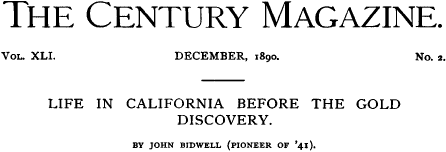|
||||
|
||||
|
|||||||||||||||||||
 Footnotes for Life in California Before the Gold Discovery
See "The First Emigrant Train to California," in THE CENTURY for November, 1890.
Men reduced to living on poor meat, and almost starving, have an intense longing for anything fat.
Among the more noted arrivals on this coast I may mention:
With the exception of the tuna, or prickly pear, these were the only cultivated fruits I can recall to mind in California, except oranges, lemons, limes, in a few places.
Mr. Schallenberger still lives at San Jose. He remained a considerable part of the winter alone with the wagons, which were buried under the snow. When the last two men made a desperate effort to escape over the mountains into California, Schallenberger tried to go with them, but was unable to bear the fatigue,and so returned about fifteen miles to the cabin they had left near Donner Lake (as it was afterward called), where he remained, theatened with starvation, till one of the party returned from the Sacramento Valley and rescued him.
See Dana's "Two Years before the Mast" for a description of the California coast at this period.
Monterey, when I first saw it (in 1844), had possbly 200 people, besides the troops, who numbered about 500. The principal foreigners living there were: Thomas O. Larkin, David Spence, W.E.P. Hartnell, James Watson, Charles Walter, A.G. Toomes, R.H. Thomes, Talbot H. Green (Paul Geddes), W. Dickey, James McKinley, Milton Little, and Dr. James Stokes. The principal natives or Mexicans were Governor Micheltorena, Manuel Jimeno, Jose Castro, Juan Malarine, Francisco Arce, Don Jose Abrego. Larkin received his comission as American consul for California, at Mazatlan, in 1844. On his return to Monterey the woman who washed his clothes took the small-pox. Larkin's whole family had it; it spread, and the number of deaths was fearful, amounting to over eighty.
When I first saw Santa Barbara, February 5, 1845, the old Mission buildings were the principal ones. The town –
Los Angeles I first saw in March, 1845. It then had probably two hundred and fifty people, of whom I recall Don Abel Sterns, John Temple, Captain Alexander Bell, William Wolfskill, Lemuel Carpenter, David W. Alexander; also of Mexicans, Pio Pico (governor), Don Juan Bandini, and others. On ranches in the vicinity lived William Workman, B.D. Wilson and John Roland. At San Pedro, Captain Johnson. At Rancho Chino, Isaac Williams. At San Juan Capistrano, Don Juan Foster.
I went to San Diego, July, 1846, with Fremont's battalion, on the sloop of war "Cyane," Captain Dupont (afterwards Admiral). The population was about one hundred, among whom I recall Captain Henry D. Fitch, Don Miguel de Pedrorena, Don Santiago Arguello, the Bandini family, J.M. Estudillo, and others. Subsequently after the revolt of September, 1846, San Diego was the point from which, in January, 1847, the final conquest of California was made.
Return to "Life in California Before the Gold Discovery."
|